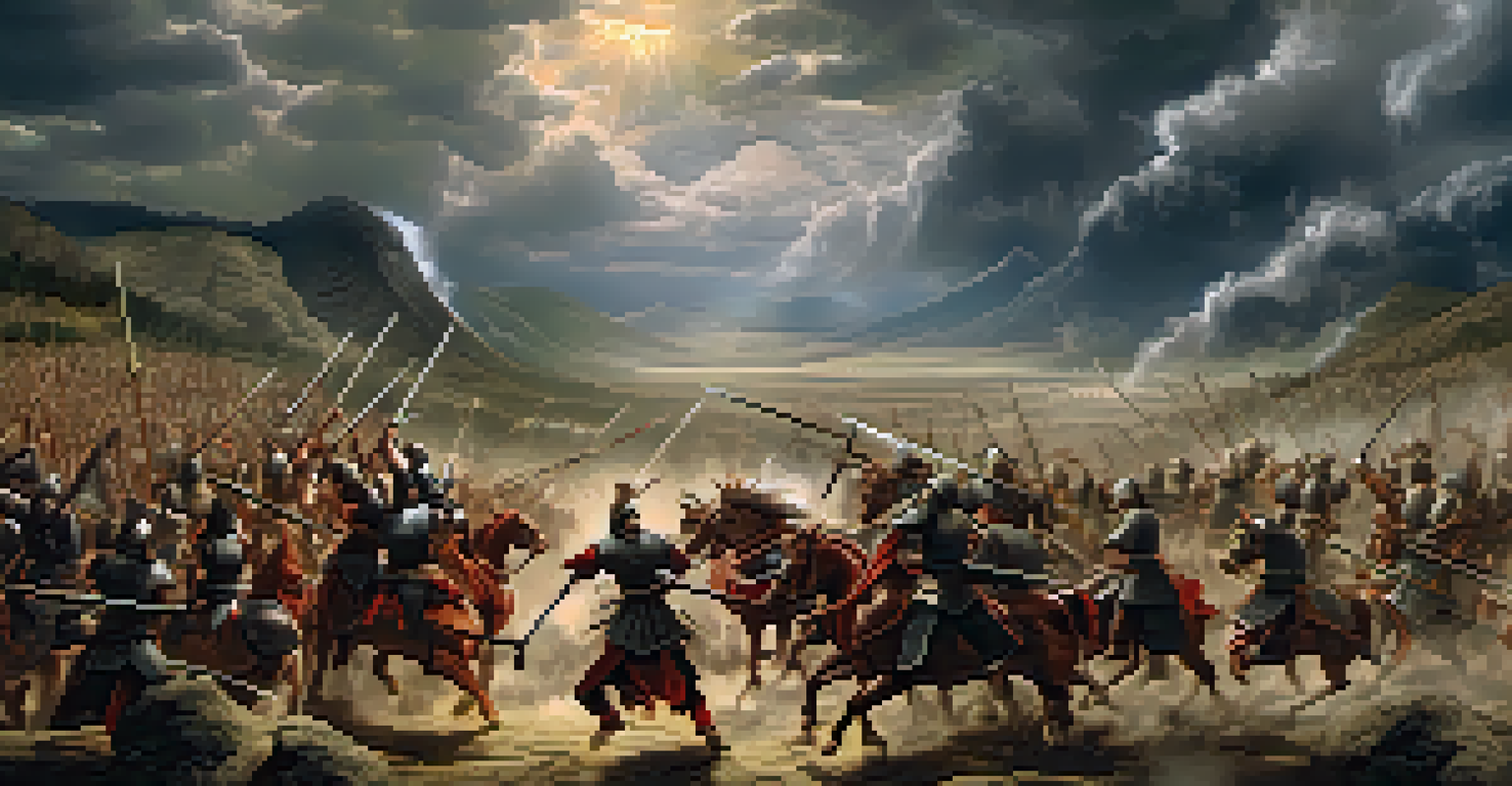Self Defense Practices in Ancient China: A Historical Perspective

The Origins of Self Defense in Ancient China
Self-defense practices in ancient China trace back thousands of years, rooted in the culture and philosophies of the time. Early martial arts were often influenced by the need for survival amid political unrest and frequent warfare. The teachings of Confucianism and Daoism also shaped these practices, emphasizing not only physical skill but also moral integrity.
The greatest victory is that which requires no battle.
Historical records suggest that self-defense was not merely about combat; it was a way of instilling discipline and respect. For instance, many martial arts schools incorporated philosophical teachings, creating a holistic approach to self-defense. This blend of physical and mental training laid the foundation for what would evolve into various traditional martial arts.
As time progressed, different regions of China developed their unique styles and techniques, reflecting local customs and needs. These practices would eventually contribute to the rich tapestry of Chinese martial arts, each style telling a story of its own within the broader context of self-defense.
Key Philosophies Influencing Self Defense Techniques
Philosophies like Daoism and Confucianism played a significant role in shaping the principles behind self-defense practices. Daoism, with its emphasis on harmony and balance, encouraged practitioners to defend themselves without seeking aggression. This concept of 'defensive offense' became a hallmark of many martial arts, promoting the idea that self-defense should be about protection rather than conflict.

Confucianism, on the other hand, stressed values such as duty, loyalty, and respect for others. These principles influenced martial artists to see their skills as a means of upholding social order. By practicing self-defense with an ethical mindset, individuals were not only protecting themselves but also contributing to the broader community.
Philosophy Shapes Self-Defense
Daoism and Confucianism influenced self-defense practices in ancient China, promoting a balance between physical skill and moral integrity.
This philosophical backdrop created a unique environment where self-defense was seen as a way to cultivate character and maintain harmony within society. As martial arts evolved, these philosophies continued to inform how techniques were taught and practiced, creating a legacy that persists in modern martial arts.
The Development of Martial Arts Schools
As self-defense gained prominence, the establishment of martial arts schools became essential for the preservation and dissemination of techniques. These schools served as training grounds where students could learn various forms of self-defense, often passed down through generations. They became havens for discipline, camaraderie, and the pursuit of mastery.
Martial arts is not about fighting; it is about building character and learning discipline.
The legendary Shaolin Temple is perhaps the most famous example, where monks trained both their bodies and minds in the art of combat. The integration of physical training, meditation, and philosophical teachings made these schools not just places of learning, but also centers for spiritual growth. This holistic approach attracted many followers, solidifying the temple's reputation as a birthplace of martial arts.
Such institutions laid the groundwork for the diverse styles we see today, each reflecting the specific techniques and philosophies of its founders. The evolution of martial arts schools marked a significant shift in how self-defense was practiced, moving from individualistic survival tactics to structured training with communal support.
Influence of Warfare on Self Defense Techniques
The tumultuous history of warfare in ancient China significantly influenced self-defense practices. As battles raged across the land, the need for effective combat techniques became paramount. Warriors and civilians alike adapted their self-defense strategies to counter the evolving tactics of their adversaries, leading to continuous innovation in martial arts.
During times of conflict, specific self-defense methods were developed to address common threats, such as armed attackers or multiple opponents. Techniques focusing on grappling and joint locks became popular, as they allowed individuals to disarm and incapacitate their foes without relying solely on brute strength. This adaptability was crucial in a society where survival often depended on quick thinking and resourcefulness.
Martial Arts Schools Emerge
The establishment of martial arts schools was crucial for preserving techniques and fostering a sense of community among practitioners.
The interplay between warfare and self-defense not only shaped the techniques themselves but also influenced the very ethos of martial arts practitioners. The lessons learned on the battlefield extended into everyday life, teaching individuals the importance of preparedness, resilience, and strategic thinking.
Cultural Significance of Self Defense Practices
Self-defense practices in ancient China were deeply intertwined with cultural identity and heritage. They were not just about personal protection but also reflected the values and traditions of the society. Festivals, rituals, and performances often showcased martial arts, celebrating the skills and discipline of practitioners as a source of national pride.
Moreover, self-defense techniques were a way to pass down history, storytelling, and lineage. Many martial arts styles are steeped in legends and folklore, making each practice a living narrative of the past. This connection to history fosters a sense of belonging and continuity among practitioners, linking them to their ancestors and cultural roots.
The cultural significance of self-defense practices continues to resonate today, as modern martial arts enthusiasts explore these traditions while adapting them to contemporary society. The blending of historical techniques with modern interpretations ensures that the rich legacy of ancient self-defense remains vibrant and relevant.
Legacy of Ancient Chinese Self Defense in Modern Martial Arts
The impact of ancient self-defense practices is evident in today’s martial arts landscape. Many popular forms, such as Kung Fu and Tai Chi, trace their origins back to these early traditions. Each style carries with it the philosophies, techniques, and histories that have been refined over centuries, showcasing the evolution of self-defense.
Modern practitioners not only learn self-defense techniques but also embrace the cultural and philosophical teachings that accompany them. This holistic approach fosters a deeper understanding of martial arts beyond mere physicality, encouraging personal growth and self-awareness. It’s about building character, discipline, and respect, just as it was in ancient times.
Cultural Heritage in Martial Arts
Ancient self-defense practices are deeply rooted in cultural identity, reflecting societal values and traditions that continue to resonate today.
As globalization continues to spread knowledge and practices, the legacy of ancient Chinese self-defense has found a place in diverse cultures worldwide. The timeless principles embedded in these martial arts resonate with many, proving that the wisdom of the past is still applicable in our modern lives.
Conclusion: The Timeless Nature of Self Defense Practices
In conclusion, the self-defense practices of ancient China offer a fascinating glimpse into a rich cultural heritage. These techniques, shaped by philosophical teachings and historical contexts, laid the groundwork for modern martial arts. The blend of physical skill, mental discipline, and ethical considerations provides a timeless framework for self-defense that remains relevant today.
As we reflect on the evolution of these practices, it’s essential to recognize their contributions to individual empowerment and community resilience. The principles of respect, harmony, and preparedness continue to be valuable lessons for practitioners everywhere, encouraging a balanced approach to self-defense.

Ultimately, the legacy of ancient Chinese self-defense is not just about combat; it’s a celebration of human spirit, culture, and the pursuit of personal growth. By understanding and appreciating this history, we can carry forward the wisdom of the past into our future endeavors.